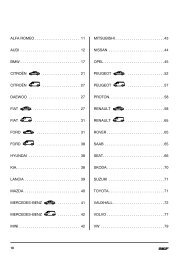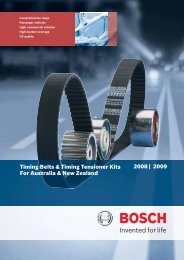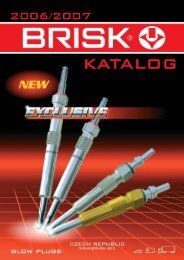spark plug cover final.indd - archiwum.moto24.biz
spark plug cover final.indd - archiwum.moto24.biz
spark plug cover final.indd - archiwum.moto24.biz
You also want an ePaper? Increase the reach of your titles
YUMPU automatically turns print PDFs into web optimized ePapers that Google loves.
A18 | Technical information<br />
FAQ’s<br />
Does technology used in racing <strong>plug</strong>s<br />
find its way into Bosch <strong>spark</strong> <strong>plug</strong>s<br />
Yes! Racing, as it has for 100 years,<br />
provides a great developmental impetus<br />
and test bed for <strong>spark</strong> <strong>plug</strong> durability<br />
and performance, and what is learned<br />
at Indy or Darlington, or Le Mans or<br />
Bathurst helps improve the <strong>spark</strong> <strong>plug</strong>s<br />
installed in today’s cars or trucks. From<br />
the 2003 and 2004 V8 Supercar<br />
Championships won by Stone Brothers<br />
Racing, Marcus Ambrose have used<br />
Bosch <strong>spark</strong> <strong>plug</strong>s.<br />
Also the first Indy 500 won by Ray<br />
Harroun’s Marmon Wasp to the last<br />
17 Indy 500 winners, and many in<br />
between, each have used Bosch <strong>spark</strong><br />
<strong>plug</strong>s.<br />
Many premium passenger car <strong>spark</strong><br />
<strong>plug</strong>s use multiple ground electrodes<br />
and precious metals, such as yttrium<br />
and platinum, which are a direct result<br />
of their development and testing in long<br />
distance racing.<br />
Multi Ground.<br />
Plugs with multiple ground electrodes<br />
are called multi ground. These <strong>plug</strong>s<br />
also use surface gap <strong>spark</strong> patterns and<br />
the multiple ground electrodes increase<br />
service life.<br />
Surface Gap<br />
Surface gap technology is when the<br />
ground electrode is to the side of the<br />
centre electrode. There can be no<br />
ground electrode (racing applications),<br />
multiple ground electrodes (PT+4 and<br />
PT2), or a single ground electrode.<br />
These <strong>spark</strong> <strong>plug</strong>s have improved<br />
efficiency and a higher probability of<br />
igniting a lean air/fuel mixture.<br />
Resistor<br />
Many <strong>spark</strong> <strong>plug</strong>s have a special<br />
conductive glass seal between the<br />
centre electrode and the terminal<br />
stud. This seal acts as a resistor in the<br />
<strong>plug</strong> which reduces the transmission<br />
of pulses of energy to the ignition<br />
cables. These pulses can cause Radio<br />
Frequency Interference (RFI) with<br />
electrical components in the car. For<br />
some newer cars, resistor <strong>plug</strong>s are<br />
required for effective communication<br />
between the <strong>plug</strong>s and the electronic<br />
ignition.<br />
GLOSSARY<br />
Radio Frequency Interference (RFI)<br />
When the <strong>spark</strong> <strong>plug</strong> creates a <strong>spark</strong>,<br />
a high frequency burst of energy is<br />
created. If this energy was to travel<br />
through the ignition wires, it could<br />
cause interference with other sensitive<br />
electronic devices, such as the radio<br />
or electronic control units. The resistor<br />
in the <strong>spark</strong> <strong>plug</strong> reduces this energy<br />
before it causes interference with other<br />
electrical components.<br />
Fouling<br />
Fouling occurs when a <strong>plug</strong> becomes<br />
contaminated with fuel, oil, or other<br />
contaminates that prevent the <strong>plug</strong><br />
from generating a <strong>spark</strong>. Most <strong>plug</strong>s<br />
today are designed to reduce fouling<br />
and become self-cleaning when they<br />
reach 500 degrees Celsius. However,<br />
short trips, low speed driving, improper<br />
<strong>spark</strong> <strong>plug</strong> heat range (too cold),<br />
improper timing, or an oil leak in the<br />
combustion chamber can cause a <strong>spark</strong><br />
<strong>plug</strong> to become fouled.<br />
Bridging<br />
Over time, contaminants can build on<br />
the surface of the <strong>spark</strong> <strong>plug</strong> if it does<br />
not reach self-cleaning temperature<br />
often. These build-ups can grow<br />
between the electrodes until they<br />
are actually connected by a bridge of<br />
contaminants. This will often cause<br />
misfire<br />
Flashover<br />
Occurs when the <strong>spark</strong> does not jump<br />
between the electrodes within the<br />
combustion chamber, but instead<br />
jumps between the metal shell and the<br />
terminal on top of the <strong>plug</strong>. This will<br />
always cause a misfire since the air/fuel<br />
mixture will not be ignited. Bosch <strong>spark</strong><br />
<strong>plug</strong>s have a ribbed insulator to prevent<br />
flashover.<br />
Quenching<br />
The purpose of a <strong>spark</strong> <strong>plug</strong> is to<br />
introduce enough heat into the<br />
combustion chamber to initiate a<br />
smooth burn of the air/fuel mixture.<br />
Quenching occurs when that heat<br />
generated by the <strong>spark</strong> is re-absorbed<br />
back into the ground electrode, the<br />
centre electrode, and the ceramic<br />
insulation. To reduce quenching and<br />
ensure an efficient transfer of heat,<br />
Bosch Platinum+4 and Platinum2 <strong>spark</strong><br />
<strong>plug</strong>s use surface gap technologies.<br />
Bosch Automotive Aftermarket 2008










